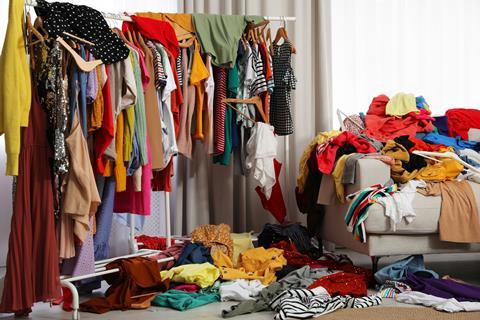Hannah Wickens explains why the recent French bill to curb budget clothing manufacturers is so important, and looks at what we can do to be less wasteful with our clothes.
In March this year, France issued a bill banning ultra-fast fashion in a quest to stifle the increasing global impact that the textile industry is having on the environment, with a staggering 10% of annual global carbon emissions generated by clothes manufacturers (Oxfam.org.uk).

In practice, this law will trim the excess that perpetrators such as online retailers Shien and Temu yield, with daily production of 10,000 items of low grade, synthetically made budget clothes. These marketplace moguls will face fines for the advertising and selling of such products, decreasing their profits, and eventually making it untenable to continue – perhaps retribution for their flagrant disregard of environmental and economic concerns.
In addition to penalising the fast fashion sector, individual buyers will incur an excess per item, thereby steering the masses toward supporting ethical brands, or procuring second-hand clothing - a choice they’re actively endorsing with subsidised rates, knowing that there are enough clothes in circulation to dress us all for the next 100 years.
In addition to penalising the fast fashion sector, individual buyers will incur an excess per item, thereby steering the masses toward supporting ethical brands
These incremental steps, predicted to spread globally, initiate a teasing away from the current fast-track to destruction. Further action should focus on the seductive nature of tailored and targeted advertisements, and the techniques that pressurise consumers toward impulsive spending, with language that urges quick fixes on items that are ‘selling out’.
As a reformed clothes addict, I can testify to the compelling lure of these pop-up messages that jolt a reflex-buy response. However, as my identity has solidified with knowledge of my original design, who God created me to be, so has my fashion sense, thereby reducing my motivation to spend. Clothes are an extension of self and in earlier days when my confidence was lower, my desire to conform was greater and with that, an assumed need for a wardrobe enabling me to join a tribe.
As a reformed clothes addict, I can testify to the compelling lure of these pop-up messages that jolt a reflex-buy response.
School uniform was an equaliser, but university propelled me into the wider world where clothing denotes rank, whether literal or created; I was working bar jobs to afford clothes and the greater my consumption, the greater my appetite for fashion. The plight of this fashion trap is captured perfectly in the book that became a film, Confessions of a Shopaholic (2009).
Once my credit card hit crisis, I opted for Primark’s similar garments with half the price tag. But when I realised how budget clothing impacts detrimentally on the environment, I reduced my spending. Then the pandemic jolted the world with an anxiety-inducing lockdown. Budget fashion became ubiquitous, easily accessible, and affordable retail therapy; a well-known antidote to stress. Shein grew exponentially - a trend that hasn’t yet bucked.
As normality returned, so did awareness. Educators of less wasteful living, such as Kezia Neush of The Whole Home, informed me about the virtues of second-hand clothing, twinned with knowledge of microfibres in synthetically made garments producing microplastics that infiltrate our water systems.
In God’s original design, he spoke with Adam and Eve about caring for our planet, a responsibility we have today. Additionally, Jesus urges us not to stress about what we’ll wear and the Israelites apparently succeeded in preserving their clothes throughout forty years of wilderness wearing; an aspiration!
Read more on sustainability and fashion
Why Christians should think twice before buying fast fashion
You’ve heard of fasting food and maybe even your phone… but could you fast clothes?
More realistically, tweaking spending habits by choosing clothes from charity shops or pre-loved clothing apps will help curb the 300,000 tonnes of textile waste that is supposedly found in household bins each year. Gen Z have been defining this decade with thrifty habits. Personally, I buy a few quality items from reputable designers via Vinted - an easy to navigate used-clothes app - each season, that will hopefully be worn for many years. I also sell items this way which feels like a global clothes swap; sustainability within community.
I support retailers that display transparent ethical practices, such as Monsoon, buying a couple of stand-alone pieces annually. Our wider family has embraced a creative idea for parties, with a price limited second-hand treasure hunt to fit a theme, as celebrations can often generate excessive spending for one-off pieces.
In raising three girls, I want them to be mindful about what they purchase, so I include them in used-clothing hunts, which they now extend to source clothes for their dolls.
And so, the circle of conscious consumerism continues.




































1 Reader's comment